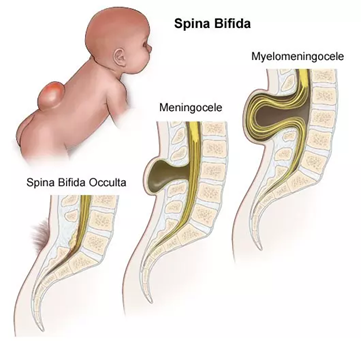A nurse is caring for a newborn who has a myelomeningocele and is admitted to the newborn intensive care unit (NICU) to await surgery. Which of the following nursing goals is priority in the care of this infant?
Promote maternal-infant bonding
Provide age-appropriate stimulation.
Educate the parents about the defect.
Maintain integrity of the sac.
The Correct Answer is D
A. Promote maternal-infant bonding: While promoting maternal-infant bonding is essential for the overall well-being of the newborn and family, it may not be the priority in this situation. The immediate focus is on medical management and preventing complications associated with the myelomeningocele.
B. Provide age-appropriate stimulation: Age-appropriate stimulation is important for newborn development, but in the case of a newborn with a myelomeningocele awaiting surgery, the priority is to minimize any potential risk of injury or infection to the exposed neural tissue.
C. Educate the parents about the defect: Education about the myelomeningocele and its long-term implications is crucial for the parents' understanding and ability to care for their child. However, while important, this may not be the priority at the immediate moment.
D. Maintain integrity of the sac: This is the priority nursing goal in caring for a newborn with a myelomeningocele awaiting surgery. The sac covering the exposed neural tissue must be carefully protected to prevent infection and further damage. Measures such as keeping the sac moist with sterile saline dressings and preventing trauma to the area are essential to maintain its integrity.

Nursing Test Bank
Naxlex Comprehensive Predictor Exams
Related Questions
Correct Answer is D
Explanation
A. Promote maternal-infant bonding: While promoting maternal-infant bonding is essential for the overall well-being of the newborn and family, it may not be the priority in this situation. The immediate focus is on medical management and preventing complications associated with the myelomeningocele.
B. Provide age-appropriate stimulation: Age-appropriate stimulation is important for newborn development, but in the case of a newborn with a myelomeningocele awaiting surgery, the priority is to minimize any potential risk of injury or infection to the exposed neural tissue.
C. Educate the parents about the defect: Education about the myelomeningocele and its long-term implications is crucial for the parents' understanding and ability to care for their child. However, while important, this may not be the priority at the immediate moment.
D. Maintain integrity of the sac: This is the priority nursing goal in caring for a newborn with a myelomeningocele awaiting surgery. The sac covering the exposed neural tissue must be carefully protected to prevent infection and further damage. Measures such as keeping the sac moist with sterile saline dressings and preventing trauma to the area are essential to maintain its integrity.

Correct Answer is A
Explanation
A. Upright: This position allows for better expansion of the lungs and improved ventilation-perfusion matching, as gravity helps the diaphragm move downward and expand the lungs. It is often beneficial for patients with respiratory distress or failure.
B. Supine: While lying flat on the back (supine position) may be comfortable for some patients, it can restrict lung expansion, especially in individuals with compromised respiratory function. This position may not be ideal for maximal lung expansion in this scenario.
C. Prone: The prone position involves lying flat on the abdomen. In some cases, especially in adults with acute respiratory distress syndrome (ARDS), prone positioning has been shown to improve oxygenation by optimizing lung mechanics. However, it may not be practical or comfortable for all patients and is not typically used as a first-line intervention in school-age children with pneumonia.
D. Side-lying: While side-lying positions can sometimes improve lung expansion on the dependent side, it may not be as effective as the upright position in maximizing lung expansion, especially in cases of respiratory failure.
Whether you are a student looking to ace your exams or a practicing nurse seeking to enhance your expertise , our nursing education contents will empower you with the confidence and competence to make a difference in the lives of patients and become a respected leader in the healthcare field.
Visit Naxlex, invest in your future and unlock endless possibilities with our unparalleled nursing education contents today
Report Wrong Answer on the Current Question
Do you disagree with the answer? If yes, what is your expected answer? Explain.
Kindly be descriptive with the issue you are facing.
